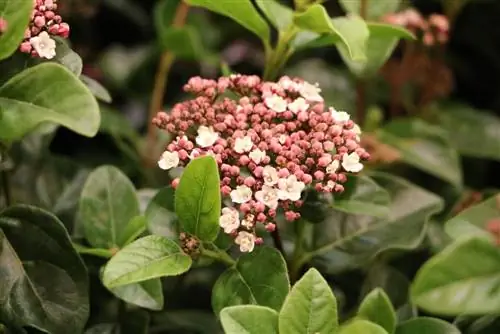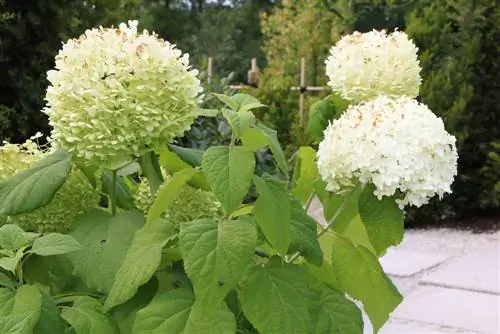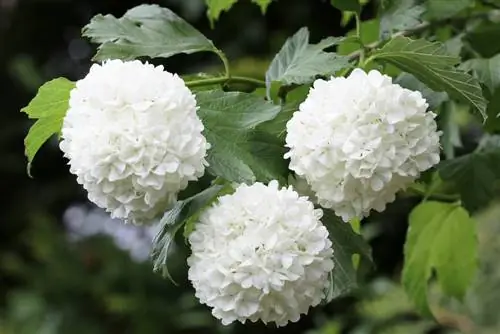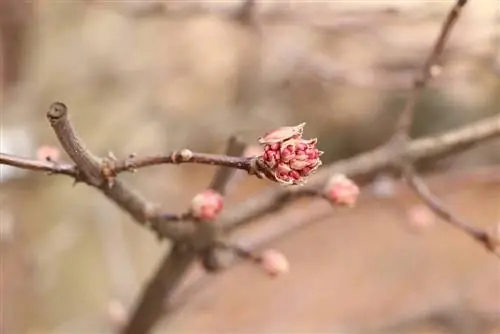- Author admin [email protected].
- Public 2023-12-17 03:39.
- Last modified 2025-01-24 12:45.
Home gardens don't have to be dreary and bare in winter, as the evergreen snowball impressively shows. Around 150 different species of the honeysuckle plant are known, some of which also shine in full bloom in the autumn and winter months. Short-growing and frost-susceptible varieties can be cultivated in pots on the balcony or terrace. Other representatives of viburnum reach a height of up to 4 meters and are suitable for solitary or hedge planting.
Location & Soil
The special flowering tree is versatile; the species diversity includes not only evergreen plants but also deciduous representatives of viburnum. How much sunlight the plant with its fascinating flowers can tolerate depends on the variety you choose. While some viburnum species thrive in full sun, others require a partially shaded planting location. A few varieties also tolerate shady places, but these plants are sensitive to direct and long-lasting sunlight. Evergreen viburnum should be cultivated in the garden protected from the wind. To promote the growth of viburnum, you should use a humus-rich, deep and slightly alkaline substrate. The evergreen snowball also makes this claim when it is kept in a bucket. You should enrich lean or dry soils with humus, pebbles and small amounts of clay. Regular mulching maintains and promotes the permeability of the soil. Nutrients and water can penetrate to the roots of the plants more quickly.
Watering & Fertilizing
Waterlogging and excessive dryness affect the evergreen viburnum. Older plants can be left to their own devices for a short time on hot summer days, but the formation of the lush flowers may suffer as a result. The substrate of young and newly planted viburnum plants should be kept moderately moist. Water again as soon as the top layer of soil has noticeably dried out. The root ball of evergreen plants must not dry out even in winter. In the cold season you should therefore water with lukewarm water on frost-free days.
Some varieties of the evergreen viburnum are sensitive to frost, which is why they should only be kept as container plants. During the main growing season, these plants are supplied with liquid fertilizer every 4 to 6 weeks. Outdoors you can use compost, coffee grounds or horn shavings. Work this material carefully into the soil in early spring and late summer. A thick layer of bark mulch suppresses the growth of unwanted plants and at the same time supplies the soil with important nutrients and minerals.
Plants
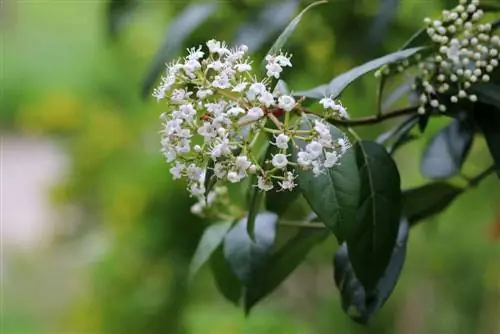
The ideal time for planting viburnum depends on the type of cultivation. While the plants in the planter can be used all year round, you should plant the evergreen ornamental trees outdoors in autumn. Maintain a minimum distance of 1.5 to 3 meters from other plants and walls. This means that all Viburnum species can develop optimally and shine in their full bloom.
- Give the plant a 24-hour water bath.
- Free the substrate of weeds and old roots.
- The planting hole should be 1/3 larger than the snowball's root ball.
- Mix the excavated earth with humus and, if necessary, with pebbles.
- Insert the evergreen viburnum up to the upper root neck.
- Fill back the substrate and press it lightly.
- Pour vigorously.
Cultivating evergreen snowballs in planters is also possible without much effort. Choose a sturdy container and create drainage made of porous material. Lava grit, among other things, has proven itself useful. Expanded clay, pebbles and pottery shards. If you purchase frost-sensitive plants in winter, they should be kept in a bright room until spring. As soon as the temperatures rise above 5 °C, the plants and their containers can be moved outdoors.
Propagate
Evergreen Viburnum species are propagated via woody cuttings. To do this, shoots about 10 cm long are cut by October. The roots develop at a room temperature of around 20 °C.
- Remove all lower pairs of leaves.
- Place 2/3 of the cuttings in lean substrate.
- The location should be bright, but not sunny.
- Keep the soil sufficiently moist.
As soon as the first new shoot and leaf tips appear, the cuttings can be transplanted into normal, prepared substrate. Don't lose patience when rooting and always cut several cuttings.
Cutting
Pruning viburnum can be counterproductive and have a negative effect on the growth habit. If thinning is necessary, this should be done immediately after flowering. Severe frost can affect even robust viburnum varieties and cause damage. Dead shoots are shortened in spring until they reach living tissue. By carefully scratching the bark, you can see whether there is still life in the evergreen snowball. Even if the non-deciduous viburnum varieties are less susceptible to fungal pathogens and pests, you should still clean and disinfect the tools you use sufficiently before and after work.
Wintering
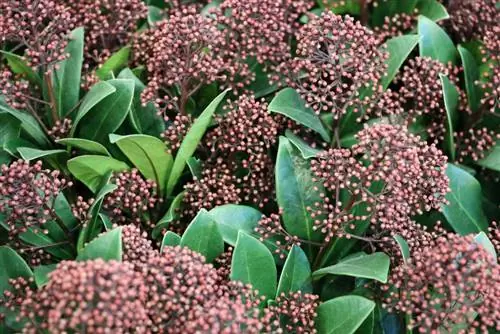
Winter-hardy varieties can be safely left outdoors, just apply a protective layer of compost, bark mulch or brushwood. Viburnum species that are sensitive to frost and snowballs grown in pots should be moved to winter storage from October onwards. Here the plants are overwintered at around 10°C until next spring. The water supply for evergreen plants must not dry up even in the cold season.
Tip:
Almost all plant parts of the evergreen viburnum are considered poisonous in raw form. Therefore, avoid contact of plant sap with mucous membranes and open wounds.
Varieties
- Viburnum rhytidophyllum: Also known commercially as “evergreen tongue viburnum”. This variety is known for its large, white flowers. Can reach a height of up to 3 meters. The creamy white flowers appear from May to June. The plant tolerates shady locations and is considered frost hardy.
- Viburnum davidii: This low-growing variety reaches a maximum height of 50 cm. This ornamental tree with its pink and white flowers is particularly effective when planted in groups, for example as a bed border. The plant is also known as “cushion viburnum.”
- Viburnum x bodnantense: Often also found under the names scented or winter snowball. The pink-white flowers of this fascinating variety exude a fragrant scent.
- Viburnum x burkwoodii: The Easter snowball reaches a circumference and a height of up to 300 cm. The small white flowers are only about 1 cm large and exude a vanilla-like scent.
- Viburnum tinus: Also called laurel or Mediterranean quickball. The plant produces red flower buds in January. Not frost resistant.
Conclusion
Evergreen viburnum is an interesting plant; the individual varieties not only differ in height, but also vary in flowering. The robust honeysuckle plants can be cultivated in many ways in the garden; the dark green foliage provides an interesting color contrast. Passionate hobby gardeners only have to spend a little time and effort caring for the evergreen plants; the berries offer birds a rich source of food.
What you should know about the evergreen viburnum soon
Location
The evergreen viburnum feels most comfortable in a sunny location, but also copes quite well with partial shade. Some species are even suitable for shady locations. A place that is somewhat sheltered from the wind is best. The less sun the trees have, the less they bloom. Full midday sun is not good for some of the snowballs either; winter sun in particular can cause burns to the evergreen leaves.
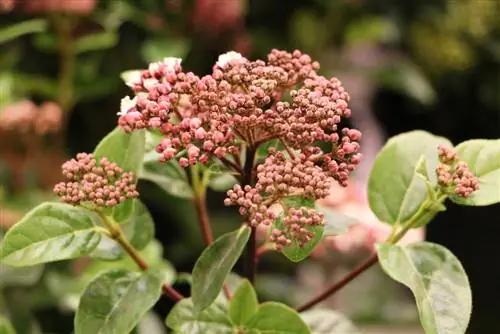
Planting substrate
The plants like normal, loose, slightly moist and nutrient-rich soil. He can be a little angry. Planting takes place in autumn. The planting substrate must be well-drained. Waterlogging is not tolerated. But drought is not good either. You have to find a he althy balance. In any case, you should only water when the top layer of soil has dried out. It's best to mulch so you don't need to fertilize any more. You don't have to water much either.
Watering and fertilizing
Potted plants must not dry out. They also need to be watered in winter, of course only when there is no frost. It should only be watered when the top layer of soil has dried.
Wintering
Some of the evergreen snowballs are only partially hardy (Viburnum tinus). Therefore, it is better to cultivate it as a container plant. It is best to overwinter them in a cold house. They should overwinter outside in a protected, warm place. You put the bucket a little higher and pack it well.
Tip:
The evergreen snowballs that bloom early in the year should be protected from frost.
Cut
Most evergreen viburnums are very tolerant of cutting. They can be cut back heavily. Depending on when you cut, flower roots will also be removed. If possible, you should prune after flowering. As a rule, the evergreen snowballs are only thinned out a little. Old wood is cut off close to the ground after flowering. You prune for the first time after about three or four years and then about every two or three years. Weak new shoots are shortened, as are shoots that are too long. Cut out anything that has dried up or is horizontal.
Tip:
Pruning allows for better branching.
Propagation
The evergreen snowballs are propagated by cuttings. They are cut from August to October.
Diseases and pests
Aphids love the snowballs. Sometimes there are so many of them on the plants that the entire flower fails.

